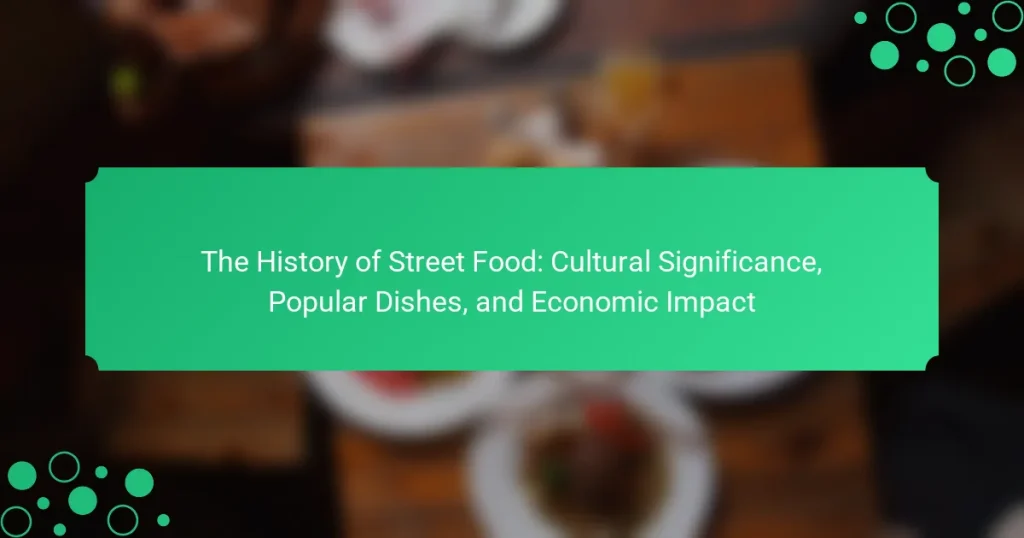Street food, defined as food sold by vendors in public spaces, has a rich history that spans ancient civilizations to modern urban life. The article explores the cultural significance of street food, highlighting its origins in ancient Rome and Greece, as well as its deep roots in Asian cultures, particularly in China and India. It further examines the global expansion of street food in the 19th century, driven by urbanization and immigration, and its recognition as a culinary trend by the late 20th century. Additionally, the article discusses the economic impact of street food, including its role in job creation, revenue generation, and tourism, while also addressing sustainable practices that can enhance the promotion of street food within communities.

What is the history of street food?
Street food has a long and diverse history that dates back to ancient civilizations. In ancient Rome, vendors sold food on the streets to cater to the working class. Street food was also prevalent in ancient Greece, where it included items like bread and cheese. The concept of food sold in public spaces continued through the Middle Ages in Europe, with vendors selling pies and pastries.
In Asia, street food has deep cultural roots, with records of vendors selling noodles and rice dishes in China as early as the Tang Dynasty (618–907 AD). The rise of street food culture in India can be traced back to the Mughal Empire, where kebabs and biryanis were sold in markets.
During the 19th century, street food expanded globally, influenced by urbanization and migration. In the United States, food carts became popular among immigrants, offering diverse cuisines. By the late 20th century, street food gained recognition as a culinary trend, celebrated for its authenticity and cultural significance.
Today, street food is a vital part of urban life worldwide, reflecting local flavors and traditions. It contributes significantly to the economy and community, providing affordable dining options and supporting local vendors.
How has street food evolved over time?
Street food has evolved significantly over time, reflecting changes in culture, economy, and technology. Historically, street food dates back to ancient civilizations, where vendors sold food near marketplaces. In the Middle Ages, street food became popular in Europe, providing affordable meals for the working class. The Industrial Revolution further transformed street food, as urbanization led to increased demand for quick and convenient meals.
In the 20th century, globalization introduced diverse culinary influences, expanding street food options worldwide. Modern street food often incorporates gourmet elements, appealing to a broader audience. Today, food trucks and pop-up stalls innovate traditional street food, enhancing presentation and quality.
According to a report by the Food and Agriculture Organization, street food contributes significantly to urban economies by providing employment and affordable nutrition. This evolution showcases street food’s adaptability and cultural significance in a changing world.
What are the earliest records of street food in history?
The earliest records of street food date back to ancient civilizations. In Ancient Rome, vendors sold bread, cheese, and wine on the streets. Archaeological evidence indicates that street food was prevalent in Ancient Greece as well. Vendors offered items like olives and fish. In 12th century China, food stalls were common in cities. They served noodles, dumplings, and other dishes. These historical instances highlight the long-standing tradition of street food across cultures.
How did cultural exchanges influence street food development?
Cultural exchanges significantly influenced street food development by introducing diverse culinary practices and ingredients. These exchanges occurred through trade, migration, and globalization. For example, the Silk Road facilitated the spread of spices and cooking techniques across Asia and Europe. As people moved, they brought their food traditions, leading to hybrid dishes. In cities, street vendors adapted these influences to local tastes and available resources. This resulted in unique street food offerings, such as tacos in Mexico, which blend Indigenous and Spanish flavors. Historical events, like colonization, further shaped street food by merging cuisines. Overall, cultural exchanges enriched street food, making it a dynamic reflection of societal interactions.
Why is street food culturally significant?
Street food is culturally significant because it reflects local traditions and culinary practices. It serves as a form of social interaction and community bonding. Street food often showcases regional ingredients and flavors unique to specific areas. This type of food can be an accessible and affordable option for many people. It also supports local economies by providing income for vendors. Historical evidence shows that street food has been a part of urban life for centuries. For example, ancient Rome had street vendors selling food to the public. In many cultures, street food festivals celebrate culinary heritage and diversity. These factors contribute to the cultural importance of street food in societies worldwide.
What role does street food play in local traditions and festivals?
Street food plays a vital role in local traditions and festivals. It serves as a cultural expression and reflects regional identities. Street food often features traditional recipes passed down through generations. Festivals frequently showcase specific street foods that highlight local ingredients. These foods create a sense of community and shared experience among festival-goers. For example, during Diwali in India, street vendors sell sweets that are integral to the celebration. Additionally, street food can attract tourists, boosting local economies during festivals. Overall, street food enhances the festive atmosphere and preserves culinary heritage.
How does street food reflect the identity of a community?
Street food reflects the identity of a community through its unique flavors, ingredients, and preparation methods. These culinary offerings often originate from cultural traditions and local resources. For instance, a community’s history, migration patterns, and agricultural practices influence the types of street food available. Street food vendors often serve dishes that resonate with local customs and celebrations. This creates a sense of belonging and pride among community members. Additionally, street food fosters social interaction and connection among diverse groups. In cities like Bangkok and Mexico City, street food markets are central to community life. They provide a space for sharing meals and experiences, reinforcing cultural identity.
What are some popular street food dishes around the world?
Popular street food dishes around the world include tacos from Mexico, samosas from India, and banh mi from Vietnam. Tacos consist of corn tortillas filled with various ingredients like meat and vegetables. Samosas are deep-fried pastries filled with spiced potatoes or meat. Banh mi features a French baguette filled with meats, pickled vegetables, and herbs. Other notable dishes include kebabs from the Middle East, arepas from Venezuela, and crepes from France. Each dish reflects local culture and culinary practices. Street food often provides affordable and accessible meal options for people in urban areas.
What are the most iconic street food items in different cultures?
Tacos in Mexico are iconic street food items known for their versatility. They can be filled with various ingredients, including meats, beans, and vegetables. In India, samosas are a popular street food, characterized by their crispy pastry filled with spiced potatoes or meat. In Thailand, pad thai is a well-known dish, consisting of stir-fried noodles with shrimp, tofu, and peanuts. In Italy, pizza al taglio is a beloved street food, served in rectangular slices and topped with a variety of ingredients. In Japan, takoyaki are savory balls made of batter and filled with octopus, often sold from street carts. In the United States, hot dogs are a quintessential street food, commonly found at sporting events and street fairs. Each of these items reflects the culinary traditions and cultural significance of their respective regions.
How do regional ingredients shape street food offerings?
Regional ingredients significantly shape street food offerings by influencing flavor profiles and dish variations. Local produce, spices, and meats determine the unique tastes of street food in different areas. For example, in Mexico, corn and beans are staple ingredients, leading to dishes like tacos and tamales. In contrast, Southeast Asian street food often features rice and seafood, resulting in dishes like pho and satay.
The availability of ingredients also impacts preparation methods. In regions with abundant fresh herbs, such as Thailand, street food often incorporates these for vibrant flavors. Seasonal ingredients can lead to temporary street food offerings, showcasing local harvests.
Cultural traditions and historical practices further influence ingredient choices. For instance, Indian street food often reflects regional spices and cooking techniques, creating diverse offerings across the country. This connection between regional ingredients and street food highlights the cultural significance of local cuisine.
Overall, regional ingredients play a crucial role in defining the identity and diversity of street food offerings worldwide.

What economic impact does street food have?
Street food significantly contributes to local economies. It provides affordable dining options for consumers, enhancing food accessibility. Street food vendors create jobs, supporting local employment rates. In many cities, street food generates substantial revenue through sales and taxes. A study by the Food and Agriculture Organization reported that street food contributes to 2.5 billion dollars in global sales annually. Additionally, street food promotes tourism, attracting visitors seeking authentic local cuisine. This influx of tourists can boost surrounding businesses, further stimulating the economy. Overall, street food plays a vital role in economic development and community livelihood.
How does street food contribute to local economies?
Street food contributes to local economies by generating income and creating jobs. It provides affordable dining options for consumers. Street vendors often have lower startup costs compared to traditional restaurants. This accessibility encourages entrepreneurship among local residents.
According to a study by the World Bank, street food markets can significantly boost local economic activity. In many urban areas, street food vendors contribute to tourism revenue. They attract visitors seeking authentic local cuisine. This influx of tourists stimulates surrounding businesses as well.
Additionally, street food can enhance community cohesion. It fosters social interactions among residents and visitors alike. Overall, street food plays a vital role in economic development and cultural exchange.
What is the role of street food vendors in job creation?
Street food vendors play a significant role in job creation. They provide employment opportunities for individuals in various communities. Many vendors hire local workers to help with food preparation and sales. This creates jobs that often require minimal skills and low startup costs. According to the World Bank, street food vendors contribute to urban economies by generating income for thousands of people. They also stimulate local economies by sourcing ingredients from local suppliers. This interconnectedness fosters economic growth within communities. Additionally, street food vendors often operate flexible hours, accommodating various job seekers. Overall, street food vending is a vital source of employment in many regions.
How does street food tourism affect local businesses?
Street food tourism positively affects local businesses by increasing foot traffic and sales. It attracts tourists who seek authentic culinary experiences. Local vendors benefit from heightened visibility and customer engagement. Increased demand for street food can lead to job creation within the community. A study by the World Bank highlighted that street food markets contribute significantly to local economies. In cities like Bangkok, street food tourism generates millions in revenue annually. This influx supports surrounding businesses, including shops and restaurants. Overall, street food tourism fosters economic growth and cultural exchange within local communities.
What challenges do street food vendors face?
Street food vendors face numerous challenges that impact their operations. Health regulations can be stringent, requiring permits and inspections. Many vendors struggle with limited access to clean water and sanitation facilities. Competition is intense, making it difficult to attract customers. Economic instability can affect purchasing power, leading to decreased sales. Additionally, street food vendors often deal with fluctuating weather conditions that can disrupt business. Safety concerns, including potential harassment or theft, pose significant risks. Finally, vendors may lack access to financial resources, hindering their ability to invest in their business.
How do regulations and health standards impact street food operations?
Regulations and health standards significantly impact street food operations by ensuring food safety and hygiene. Compliance with these regulations is crucial for vendors to operate legally. Health inspections assess cleanliness, food handling practices, and storage conditions. Failure to meet these standards can result in fines or closure. Regulations also influence consumer trust in street food. When vendors adhere to health standards, they attract more customers. For example, a study in the Journal of Food Protection highlights that areas with strict food safety regulations see fewer foodborne illnesses. This shows that regulations not only protect public health but also enhance the reputation of street food vendors.
What are the common obstacles for street food entrepreneurs?
Common obstacles for street food entrepreneurs include regulatory challenges, limited access to funding, and competition. Regulatory challenges often arise from health and safety regulations. Many entrepreneurs struggle to navigate local laws and permits. Limited access to funding can hinder startup and operational costs. Traditional financing options may not be available to small vendors. Competition is fierce in popular areas, leading to price wars. Additionally, maintaining consistent quality and supply can be difficult. Weather conditions can also impact sales significantly. These factors create a challenging environment for street food entrepreneurs.

How can street food be promoted sustainably?
Street food can be promoted sustainably by utilizing eco-friendly packaging and sourcing local ingredients. Eco-friendly packaging reduces waste and environmental impact. Sourcing local ingredients supports local economies and reduces carbon footprints. Promoting street food through community events raises awareness and encourages participation. Collaborating with local farmers strengthens community ties and enhances food quality. Implementing waste management practices minimizes food waste and encourages recycling. Educating vendors about sustainability fosters responsible practices. These strategies collectively enhance the sustainability of street food promotion.
What practices can ensure the sustainability of street food?
Sustainable street food practices include sourcing local ingredients, minimizing waste, and using eco-friendly packaging. Local sourcing reduces transportation emissions and supports local economies. Minimizing waste can be achieved through portion control and composting food scraps. Eco-friendly packaging, such as biodegradable containers, reduces plastic pollution. Additionally, promoting food safety ensures public health and longevity of street food vendors. Research indicates that sustainable practices can enhance the profitability of street food businesses while benefiting the environment. Implementing these practices can lead to a more sustainable street food culture.
How can local governments support street food initiatives?
Local governments can support street food initiatives by creating favorable regulations and providing financial assistance. They can simplify licensing processes for street vendors. This encourages entrepreneurship and reduces barriers to entry. Additionally, governments can designate specific areas for street food markets. These areas can attract more customers and boost local economies. They can also offer training programs for vendors on food safety and business management. This ensures high standards and sustainability in the sector. Furthermore, local governments can promote street food through marketing campaigns. This raises awareness and appreciation for local culinary culture. Studies show that cities with supportive policies see increased street food success and community engagement.
What role do consumers play in promoting sustainable street food?
Consumers play a crucial role in promoting sustainable street food by making conscious purchasing decisions. Their choices can drive demand for locally sourced ingredients. This demand encourages vendors to adopt eco-friendly practices. Consumers also influence street food trends by favoring vendors who prioritize sustainability. Research shows that 70% of consumers prefer food options that are environmentally friendly. Additionally, consumer advocacy can lead to policy changes that support sustainable practices. By supporting sustainable street food, consumers contribute to reducing waste and carbon footprints in urban areas. Thus, consumer behavior directly impacts the sustainability of the street food industry.
What are some best practices for enjoying street food safely?
To enjoy street food safely, choose vendors with high turnover rates. Freshly prepared food is less likely to harbor bacteria. Look for stalls that maintain cleanliness and have proper food handling practices. Observe if the vendor uses gloves or utensils when serving food. Select hot food items that are cooked thoroughly. High temperatures kill harmful pathogens. Avoid raw or undercooked foods, especially seafood and meats. Drink bottled or sealed beverages to prevent contamination. Lastly, trust your instincts; if a vendor seems unsanitary, it’s best to walk away. Following these practices minimizes the risk of foodborne illnesses while enjoying street food.
How can consumers identify safe street food vendors?
Consumers can identify safe street food vendors by observing their hygiene practices. Cleanliness of the vendor’s cart or stall is crucial. Vendors should wear gloves and hairnets while preparing food. The presence of a handwashing station indicates good hygiene. Consumers should also check for proper food storage temperatures. Freshly cooked food is generally safer than pre-cooked items. High customer turnover often indicates food freshness. Additionally, positive reviews and recommendations from locals can guide consumers to trustworthy vendors. According to a study published in the Journal of Food Safety, vendors with visible hygiene practices have lower rates of foodborne illnesses.
What tips should be followed for a positive street food experience?
Choose busy stalls with long lines. This indicates popularity and food turnover. Look for vendors who follow hygiene practices. Clean preparation areas and fresh ingredients are crucial. Observe food being cooked in front of you. This ensures freshness and quality. Ask locals for recommendations. They often know the best options. Avoid food that has been sitting out for long periods. This minimizes the risk of foodborne illness. Trust your instincts regarding food safety. If something looks or smells off, it’s best to skip it. Enjoy a variety of dishes to experience local flavors. Street food offers a unique insight into the culture.
The main entity of this article is street food, which encompasses a variety of culinary offerings sold in public spaces. The article explores the historical evolution of street food from ancient civilizations to modern times, highlighting its cultural significance, popular dishes, and economic impact. It discusses how street food reflects local traditions, contributes to community identity, and supports local economies by providing affordable dining options and job creation. Additionally, the article addresses the challenges faced by street food vendors and the importance of sustainability practices in promoting this vibrant culinary culture.




